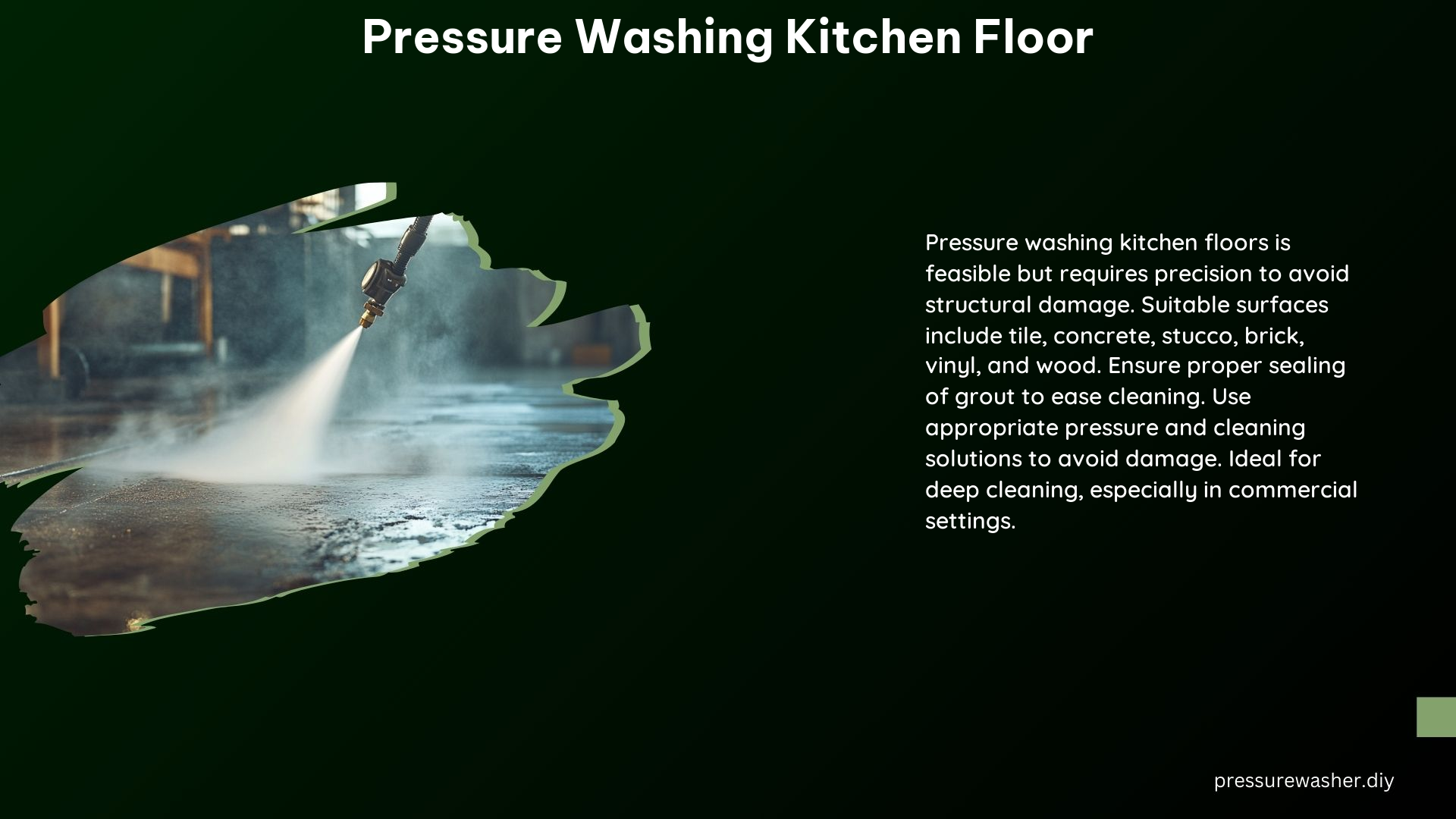Pressure washing a kitchen floor can be a highly effective way to deep clean and restore the surface, but it requires careful consideration and execution to avoid potential damage. This comprehensive guide will provide you with the necessary information and best practices to pressure wash your kitchen floor safely and effectively.
Safety and Precautions
Precision is Key
When it comes to pressure washing indoor tile, precision is crucial. The intense water pressure can easily damage the grout, tiles, and even the underlying subfloor if not used with caution. It’s essential to maintain a safe distance from the surface and adjust the pressure accordingly to avoid any structural damage.
Mitigating Water Damage
One of the primary concerns when pressure washing a kitchen floor is the potential for water damage. The high-pressure water can force its way under doors, windows, and other openings, potentially causing damage to adjacent carpets, hardwood floors, and other sensitive surfaces. It’s crucial to take measures to contain the water and prevent it from spreading to unintended areas.
Addressing Weaker Spots
Certain flooring materials, such as vinyl tile, can be more susceptible to damage from the intense pressure of power washing. In these cases, it’s important to exercise extra caution or consider alternative cleaning methods that are less likely to compromise the integrity of the floor.
Suitable Surfaces

Pressure washing can be a highly effective cleaning method for a variety of kitchen floor surfaces, including:
- Tile
- Concrete
- Stucco
- Brick
- Vinyl
- Wood
These surfaces can typically withstand the high-pressure water without sustaining significant damage, making pressure washing a cost-effective and environmentally friendly cleaning option.
Best Practices
Reserving Power Washing for Serious Cases
Power washing should be reserved for the most stubborn and difficult-to-remove dirt and grime on kitchen floors. In cases where traditional scrubbing and mopping are no longer effective, power washing can be a valuable tool to restore the floor’s cleanliness.
Starting Small
Before tackling the entire kitchen floor, it’s recommended to start with a small, inconspicuous area to test the effectiveness and safety of the pressure washing technique. This will allow you to adjust the pressure, distance, and cleaning solution as needed to ensure the best possible outcome.
Seeking Professional Guidance
If you’re unsure about the suitability of pressure washing for your kitchen floor or the proper techniques to use, it’s always advisable to consult with local flooring experts. They can provide valuable guidance and ensure the job is done safely and effectively, minimizing the risk of any unintended damage.
Additional Tips
Sealing the Grout
One important step to consider after pressure washing a kitchen floor is sealing the grout. This can help keep the grout clean and make it easier to maintain the floor’s appearance over time.
Technical Specifications
Pressure and Flow Rate
The ideal pressure and flow rate for pressure washing a kitchen floor will depend on the specific surface material and the level of dirt or grime present. As a general guideline, a pressure washer with a flow rate of 2-4 gallons per minute (GPM) and a pressure of 1,500-3,000 pounds per square inch (PSI) is typically suitable for most kitchen floors.
It’s important to note that these specifications may need to be adjusted based on the floor’s condition and the manufacturer’s recommendations for the pressure washer being used.
DIY Considerations
Equipment and Safety Gear
When pressure washing a kitchen floor, it’s essential to have the necessary equipment, including a high-quality pressure washer, a suitable hose, and appropriate safety gear such as gloves and goggles. Ensure that all equipment is in good working condition and that you follow the manufacturer’s instructions for safe operation.
Testing a Small Area
Before beginning the pressure washing process on the entire kitchen floor, it’s crucial to test the technique on a small, inconspicuous area. This will allow you to assess the effectiveness of the pressure and cleaning solution, as well as identify any potential issues or damage to the floor.
Conclusion
Pressure washing a kitchen floor can be a highly effective way to deep clean and restore the surface, but it requires careful consideration and execution to avoid potential damage. By following the safety precautions, best practices, and technical specifications outlined in this comprehensive guide, you can pressure wash your kitchen floor with confidence and achieve the desired results.
References
- https://www.steamsmartpro.com/pressure-wash-indoor-tile
- https://www.rollingsudsinc.com/commercial-kitchen/
- https://www.ozburn-hesseycompany.com/blog/2021/03/09/can-you-power-wash-floors/
